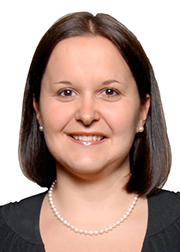
Please describe the research questions of your lab.
The overall goal of my research is to identify biomarkers and develop a deeper understanding of molecular pathogenesis of pulmonary fibrosis, granulomatous lung disease, and asthma using epigenomic and transcriptional profiling. In this work, we have identified molecular subtypes of pulmonary fibrosis, gene expression profiles of environmental exposures in asthma, and DNA methylation changes associated with the development of these diseases. Based on discoveries of the MUC5B promoter polymorphism and the airway gene expression molecular subtype of IPF, I have recently specifically focused on the study of mucociliary defects in IPF.
What genetics/genomics techniques do you utilize in your lab?
Illumina genotyping arrays, whole genome sequencing, Illumina methylation arrays, bulk RNA-seq, and bulk ATAC-seq have been in use for quite some time in our group. More recently, we have begun to use single cell/single nucleus RNA and ATAC sequencing as well as the Nanostring GeoMX spatial transcriptomics platform. On occasion, we have collaborated with groups using proteomics and metabolomics and are beginning a collaboration using CITE-seq.
Describe a key technique/assay/instrument utilized in your lab, and what questions can it answer?
An important protocol that we are trying to implement at this time is the use of the CRISPR system without nuclease activity (CRISPR/dCas9) to allow us to manipulate DNA methylation at specific loci. This is important to us to study potential function of key CpG sites/regions we have identified associated with disease. It is a multi-step protocol that involves bisulfite amplicon sequencing (BSAS) of the region on our MiSeq instrument, followed by design of guide RNAs, cloning, transfections/transductions in cell culture, and measurement of changes in methylation by BSAS to ensure CRISPR/dCas9 system worked. As the final step, we can measure gene expression, downstream signaling, and cellular phenotypes of interest.
At what point in your life did you decide you wanted to be a scientist/physician?
My great aunt was a physicist, and we used the textbook written by her in high school. I had always enjoyed math and science but that was the deciding moment for me.
Briefly describe your favorite publication that you were involved in.
In 2013, we published a large gene expression profiling the study of IPF lung tissue (Thorax. 2013;68:1114-21. PMID: 23783374). This is my favorite publication for several reasons: (1) I am proud of our careful study design and analyses that allowed us to identify airway and alveolar molecular subtypes of IPF with a high degree of confidence. (2) This study was truly a team effort as it required expertise and hard work of lab personnel, data analysts, our genomics core, and clinical collaborators. It taught me how to lead a large team effectively. (3) Identification of the airway subtype of IPF, along with discoveries of the airway mucin MUC5B genetic variant by others in our laboratory, started our investigation into injury to the distal airways in this disease. (4) This was the first omic study I performed that launched an independent line of functional follow-up studies in my laboratory. I was able to recruit a very talented cell biologist postdoctoral fellow to study the role of ciliogenesis in pulmonary fibrosis using primary cell cultures (air-liquid interface and airway-derived organoids) as well as animal models of lung fibrosis.
What is your favorite aspect of ATS?
Collaborations and participation in Section/Assembly work and leadership have been the most rewarding aspects of my involvement in ATS.
How could your research assist scientists and clinicians in other assemblies at ATS?
I am always open to collaborations with new groups to apply my expertise in omics, especially DNA methylation and gene expression profiling, to other diseases and clinical issues.
Would you be open to collaborations with SGG/or non-SGG scientists and clinicians? Do you have any potential lab openings currently or in the near future?
We have openings for both wet lab and computational postdoctoral fellows in our laboratory. Please get in touch if you would like to talk about these possibilities.
include your email address or lab website to share with potential collaborators!
Email: ivana.yang@cuanschutz.edu X: @GenomicsIvana



